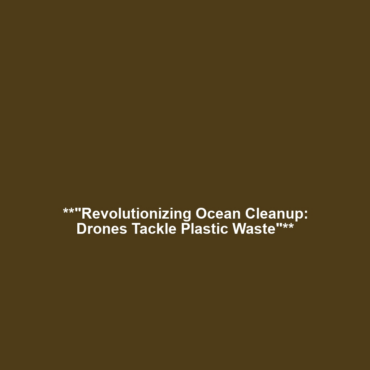Ongoing Research Into Using Drones to Clean Up Plastic Waste in Oceans
Introduction
The increasing prevalence of plastic pollution in our oceans poses a significant threat to marine ecosystems and biodiversity. In response to this pressing issue, ongoing research into using drones to clean up plastic waste in oceans has emerged as a viable solution. This innovative approach exemplifies the broader category of Drones in Science, showcasing how technology can address environmental challenges. Researchers worldwide are leveraging drones for monitoring, collection, and analysis, making significant strides toward reducing oceanic plastic waste.
Key Concepts
Understanding the intersection of drones and environmental science requires familiarity with several key concepts:
- Autonomous Drones: Advanced drone technology allows for autonomous navigation, enabling drones to cover large areas of ocean to identify and collect plastic debris.
- Remote Sensing: Drones equipped with cameras and sensors can detect plastic pollution hotspots, providing valuable data for cleanup operations.
- Data Analysis: Machine learning algorithms are employed to analyze collected data, optimizing cleanup routes and techniques.
These concepts reflect how ongoing research integrates drones into scientific applications that address plastic pollution.
Applications and Real-World Uses
Research into using drones to combat ocean plastic waste translates into several significant real-world applications:
- Monitoring Plastic Accumulation: Drones are deployed to monitor and map the distribution of plastic debris, offering insights into pollution sources and trajectories.
- Collection Efforts: Pilot programs have successfully utilized drones to carry nets and other collection devices, demonstrating their effectiveness in removing debris.
- Collaboration with NGOs: Many environmental organizations partner with researchers to implement drone technology in cleanup missions, enhancing operational efficiency.
This showcases how ongoing research into using drones directly applies to the category of Drones in Science for environmental conservation.
Current Challenges
Despite the promise of drone technology in cleanup efforts, several challenges impede progress:
- The cost of advanced technology: High initial investment in drone technology can be a barrier for many organizations.
- Regulatory Issues: Navigating airspace regulations for drone flights presents operational challenges.
- Payload Limitations: Current drones may struggle to carry sufficient weight for large-scale cleanup operations.
Addressing these challenges of using drones is crucial for enhancing their role in the ongoing fight against ocean plastic waste.
Future Research and Innovations
The future of using drones for ocean cleanup looks promising, with several innovative avenues on the horizon:
- Enhanced Sensor Technology: Future research may lead to drones equipped with improved sensors that can detect and classify different types of plastic waste more effectively.
- Swarm Technology: Research is underway to explore how swarm technology can enable multiple drones to work collaboratively, significantly increasing efficiency in cleanup operations.
- Integration with AI: Artificial intelligence may play a critical role in automating drone operations and improving data analysis.
These breakthroughs will not only enhance the effectiveness of cleanup efforts but will also solidify the role of Drones in Science as a central focus of environmental innovation.
Conclusion
In summary, ongoing research into using drones to clean up plastic waste in oceans represents a groundbreaking development within the framework of Drones in Science. By leveraging drone technology, researchers are creating new methodologies for monitoring and mitigating ocean pollution. As technology evolves, there is a call for increased collaboration among scientists, policymakers, and environmental organizations to realize the full potential of drones. For further reading on similar topics, check out our articles on drones in environmental monitoring and technological innovations in marine conservation.

Leave a Reply